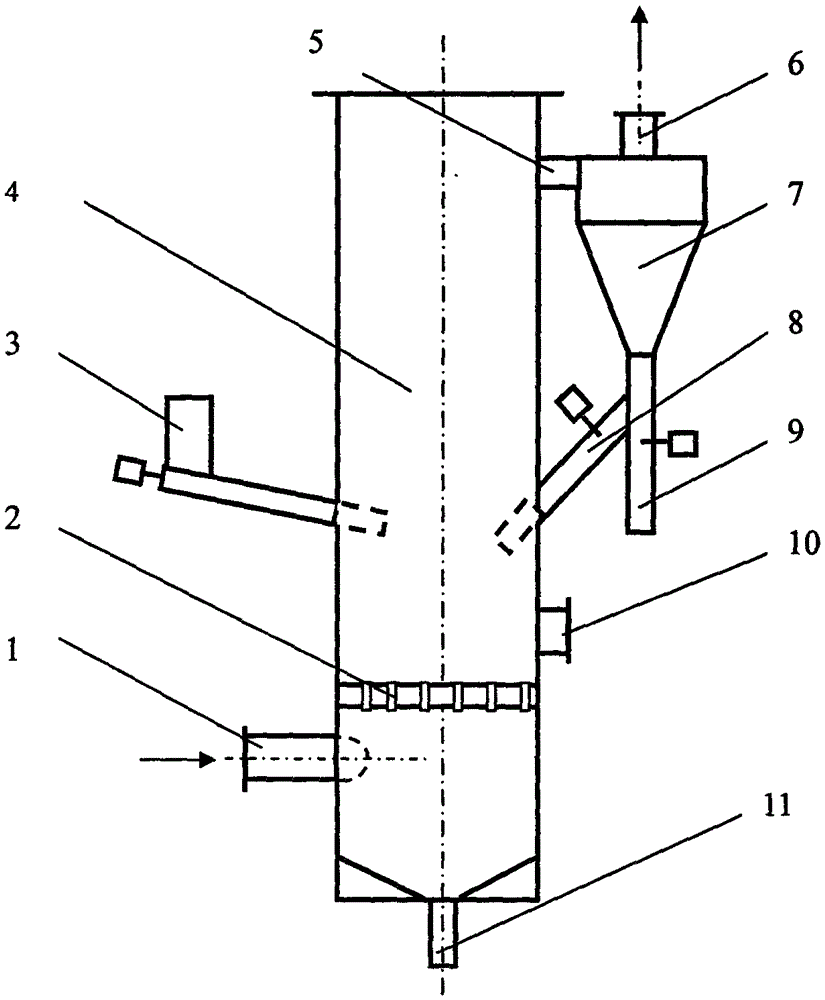Method for removing nitric oxide from gas
A nitrogen oxide and gas technology, which is applied in the field of air pollution control and related environmental protection, can solve the problems of expensive chemicals, low absorption efficiency, high operation and use costs, and achieve safe use, large processing capacity, and low investment costs and operating costs. Effect
- Summary
- Abstract
- Description
- Claims
- Application Information
AI Technical Summary
Problems solved by technology
Method used
Image
Examples
Embodiment 1
[0017] Embodiment 1: a kind of circulating fluidized bed gas-solid reaction tower device of the method for removing nitrogen oxides from gas such as figure 1 shown. The circulating fluidized bed gas-solid reaction tower has a tower diameter of Φ60 mm, a tower height of 2500 mm, and a tower body made of 316L stainless steel. The concentration of nitrogen oxides (nitric oxide is about 90%) in the gas is 500ppm, oxygen is 8% (volume), water content is 10% (volume), and the rest is nitrogen. Polyaluminum chloride is a commercially available industrial-grade powder particle with an average particle size of about 0.1mm. Polyaluminum chloride is heated to 80°C and 120°C reaction temperature respectively and then introduced into the gas-solid reaction tower. The gas temperature in the tower is respectively At 20°C, 50°C and 90°C, the gas-solid contact time in the reaction tower is about 4-6s. The mass ratio of nitrogen oxides to polyaluminum chloride is about 1:10. After the gas-so...
Embodiment 2
[0020] Example 2: Polyaluminum chloride is introduced into the gas-solid reaction tower at normal temperature, the gas temperatures in the tower are respectively 90°C, 120°C and 180°C, and the mass ratio of nitrogen oxides to polyaluminum chloride is about 1:15. Other conditions are with embodiment 1. The experimental results are shown in Table 2.
[0021] Table 2
[0022]
Embodiment 3
[0023] Embodiment 3: Use polyaluminum chloride particles as the reactant, and mix 20% (volume) of quartz sand with a particle size of about 1mm-3mm in the material. Other conditions are with embodiment 2. The experimental results are shown in Table 3.
[0024] table 3
[0025]
PUM
| Property | Measurement | Unit |
|---|---|---|
| The average particle size | aaaaa | aaaaa |
Abstract
Description
Claims
Application Information
 Login to View More
Login to View More - R&D
- Intellectual Property
- Life Sciences
- Materials
- Tech Scout
- Unparalleled Data Quality
- Higher Quality Content
- 60% Fewer Hallucinations
Browse by: Latest US Patents, China's latest patents, Technical Efficacy Thesaurus, Application Domain, Technology Topic, Popular Technical Reports.
© 2025 PatSnap. All rights reserved.Legal|Privacy policy|Modern Slavery Act Transparency Statement|Sitemap|About US| Contact US: help@patsnap.com



